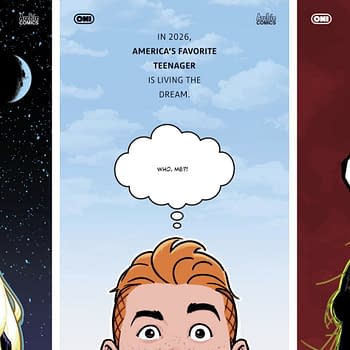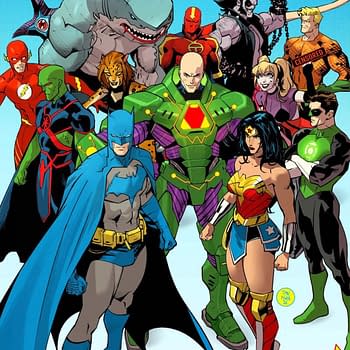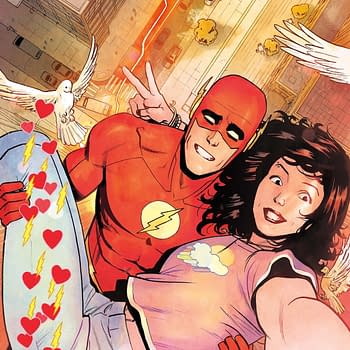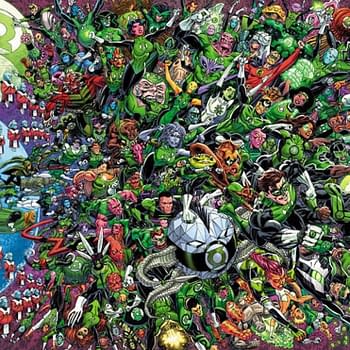Posted in: Comics, Recent Updates | Tagged: Batman, chris claremont, dc, Figures Toy Company, funko, galactus, green arrow, hasbro, hulk, iron man, marvel, mattel, Mego, neal adams, nightcrawler, Remco, Square Enix, Super 7, The Joker, The Silver Surfer, Toy Biz, Zoloworld
Toy Collecting Shifts Away From The Big Two – An Odyssey In Plastic
By Christopher Smith
As one age of toys ends, another begins. In Philip K. Dick's novel The Three Stigmata of Palmer Eldritch, his dystopian society involves those who cling to a Barbie-like doll and her utopian world, immersing themselves heavily in her false reality, which the share as a consensual delusion through a drug named Can-D. That story's always resonated with me, oddly, as someone whose escapist hobby serves, if not the same function, something about the transformative power of nostalgia and imagination. Whether you keep them sealed in their packages with dreams of reselling them to fund your children's education, open them up for the purpose of staging epic battles worthy of being chronicled by a tiny, plastic military historian someday, or turn them into fetish objects invested with a totemic, occult sense of significance like Dick's Can-D users, toy collecting – and customizing, and other forms of play – has a broad appeal within various denizens of the geek community.
Just about any and all pop-cultural properties have had some action figures, statues, small figurines, or other collectible tchotchkes ready to market (and, in some cases, bombard upon the general public with gusto). Of course, comic book/nostalgic pop cultural fans are in no way in danger of the deluge of toys to collect drying up any time soon, but there has been a sea change of sorts, particularly within the dichotomy between mass market, brick-and-mortar-presence companies such as Mattel, Hasbro, and Playmates and smaller, independent companies that have sought out the often expensive licenses associated with toys (in addition to producing their own products, often aimed at a separate, "art toy" collector sub-niche which may overlap with some of the others).
Pierre Bourdieu once wrote that capital "takes time to accumulate and which, as a potential capacity to produce profits and to reproduce itself in identical or expanded form, contains a tendency to persist in its being," of which we can see ample evidence in Hasbro and Mattel's often repetitive toy production. His concept of cultural capital examines the ways in which a community invests these objects with value based on knowledge, expertise, and status. The history of just how and why toys became sought-after objects by collector communities is an interesting one we don't have the time and space for here, but I wish to identify a recent investment of cultural capital, a shaping of the landscape, with which Mattel and Hasbro were, at times, able to serve two masters with their superhero and pop-cultural toys: a primary audience of children, and a secondary audience of collectors. This was a golden age of sorts that's now ended.
Most readers of this article are probably familiar with Marvel Legends, the revolutionary Toy Biz line that made huge strides in both toy engineering – these toys were leaps and bounds ahead of what was then commercially available in terms of articulation, which they displayed to an at times grotesque, over-the-top degree – and character selection. As it rose to its peak in the early 2000's, the 6" action figure line not only did wild things like packaging The Silver Surfer with Howard the Duck and allowing collectors to build their own, towering 18" tall Galactus, but also furthered the investment of cultural capital to the concept of action figure collecting.
Whether looking to resell for profit or serving their own devotional needs, swarms of collectors descended to the toy aisles of local chain stores, hungrily. They debated the articulation, sculpting, and selection of these toys on forums like The Fwoosh, in which a new Marvel Legends figure would receive dozens of pages of at times intensely serious commentary and discussion, which involved everything from griping about its difficulty to find without resorting to eBay, debating the company's marketing and product development decisions, absurdist jokes, rants, self-loathing (always at a peak among toy collectors), etc.
My first Marvel Legends figure was a Nightcrawler I bought in 2005, after reading the black-and-white reprints of Chris Claremont's X-Men run, which I'd recently discovered were finally available to the general public. I ripped him open the day he came in the mail (Legends were often packaged in excruciating clamshells you had to cut into with scissors, like computer hardware) and, I think, hung him by his tail (which has since been reglued a few times) from my ceiling fan. He's not worth very much but he's still one of those objects I've invested with great personal significances. I was, yes, hooked.
It didn't take long, though it was a slow process to start, for Mattel to enter into the ring, when they expanded their Batman toy license to a series of gradually improving and expanding figures in terms of character selection, which came to be known as DC Universe Classics, which emerged right as Marvel's internal restructuring shuttered Toy Biz and their toy license transferred to Hasbro. DCUC (as it came to be known) equaled Legends in many ways (though I've no doubt raised the ire of some partisan toy collector for even suggesting that), with what I'd consider a less impressive but more aesthetically pleasing form of articulation that relied a bit more obviously on part reuse.
If many of the DCUC figures bore a disconcerting similarity in terms of their body types (especially a problem with the line's female sculpts, who were often best described as "spindly"), their facial and other features were sculpted remarkably well by the Four Horsemen, a team of sculptors best compared to the fan-favorite artists and writers that can sell a comic book on their own, and whom fans often follow to creator-owned projects. Concurrent with DCUC's demise late last year, the Horsemen launched a highly successful Kickstarter campaign based on their Gothitropolis figures, an endearingly kooky – like so many oddball creator-owned comics projects – series of anthropomorphic bird warriors.
DCUC definite got its own claws into me, speaking to the nostalgic appeal that the line evoked for Kenner's Super Powers Collection, fondly remembered by 30+ comic fans as the DC superhero toy line of the early 1980s. The Horsemen, in fact, produced accurate updates of all of the Super Powers figures, even some vocally disliked by messageboard legions. Personally, I'd say the the line peaked around Wave 9 (which featured a striking Green Arrow who looks to have stepped right off of the Neal Adams page), and Wave 10 (a tough-to-find retailer exclusive that featured the in-demand Joker, a painstaking update of the Super Powers figure right down to the disturbing visage on his long-nosed mallet).
However, DCUC could only last so long, as Mattel tried to turn it into an exclusive online offering like its Masters of the Universe Classics, but failed due to low subscribers and some subpar offerings that drew little excitement or investment of cultural capital from collectors. (Meanwhile, Hasbro and Mattel started to move away from the idea of collector-focused lines and their viability at mass retail. Part of the ridiculous sideshow element of collecting would be the venom collectors held for the "peg-warmers," those figures in a certain assortment that would not sell. Some reading this may feel an instinctive tightening of the guts or a swelling of bile when I mention Wave 10 Power Girl, Wave 3 Cyborg, or that Gladiator (from the Star-Wars-scaled Marvel Universe line), of the fearsome Sh'iar Imperial Guard and the inability to move enough units and make way for the next wave.
Even worse, perhaps, was the frustration mounted by a near-catastrophic pile-up of movie-themed product, the often cheap and unimaginative Iron Man 2, The Dark Knight Rises, and Man of Steel toys which now only serve one master: the child, whom it's easy to forget as the main consumer. Or, rather, the not especially invested parent of a child who will grab anything in the shape of Iron Man or The Hulk, even if it's a dread five-point-of-articulation figure that would have seemed outdated by the mid-eighties. But child and Perky Pat devotee alike deserve better.
After Hasbro laid off Dave Vonner, part of the Marvel Legends braintrust whose inventive quirks made the Marvel Universe line such a treat (he did things like pack an intricate storyline in the figures via S.H.I.E.L.D. dossiers and put a hidden Chameleon headsculpt below Mysterio's fishbowl head), it became easier for me to jump ship, more or less. The past year has seen a rise of substandard product dominating store shelves, somehow taking the secret, for-those-in-the-know fun away from finding, say, a Killer Moth in an accurate Silver Age costume, hiding away between rows of unsold transforming power ball figures that look like crustaceans that share DNA with Voltron, the I Am T-Pain autotune microphone, and some Duck Dynasty jigsaw puzzles. The Golden Age is over, except for outliers like Hasbro's Star Wars Black Series toys, $19.99 six-inch versions of its characters, though I'm relieved not to have to try to hunt down the Boba Fett figure, which only seems to exist in a theoretical pocket universe, somewhere. Other items start to seem like a greater value for one's dollar, and going elsewhere has become more fun.
Depending on your area of interest, there's a whole host of options out there. Some have gone for the finely crafted status of exclusive, pricy import lines like Square Enix's Play Arts Kai series. Others are more interested in high-end 12" collector figures. For me, Mego-inspired revival figures have been the real charm, springing up from a cottage industry started by none other than Dr. Mego himself, an inspired mad scientist sort who began by hand-casting his own reproduction parts for the fondly remembered series of 1970's 8" dolls, then starting to produce some of his items in China. Collaborating with Mattel, Bif Bang Pow, and others, the good doctor has brought collectors a remarkable assortment of product based on everything from The Twilight Zone to The Venture Bros., which more products on the horizon.
As these companies operate on a vastly different scale from the Big Two (sound familiar?), it's a different ball game from mass-retail collecting, of course, with its own frustrations (much less hunting down product in stores, more enduring long wait times and cancellations between products). I know that I treasure the hand-molded reproduction weapons I bought from Doc to complete my vintage Mego Conan figure. In some postmodern definition of the term, the little reverse-engineered axe, sword, and gauntlets seem like an authentic piece of American folk art.
While it initially drew some criticism for taking on too many licenses at once, leading to some fans skeptical about its ability to deliver on all this promised product, Figures Toy Company has been doing great things with the DC Mego doll license it bought from Mattel, who had a somewhat abortive run producing its own homage to the 8" clothed format. (They did produce some great figures, though, and had Doc Mego on board as a designer; unfortunately, they focused too heavily on Green Lantern figures and truncated the line before producing cornerstones like a Joker or Robin.) At the time of this article, they've put out two waves of reproduced Mego Batman figures, and have just announced new characters like Alfred and Commissioner Gordon, as well as Teen Titans members like Cyborg and Nightwing. Along with the 1966 TV Batman figures, it's a true embarrassment of riches.
Meanwhile, other, more pure expressions of the retro toyline are blossoming. San Francisco's Super 7 toys have, with Funko joining them to meet consumer demand, reissued unproduced Kenner prototypes from 1979's Alien, and these figures, which fit in perfectly with Kenner's Star Wars and Indiana Jones figures of the era, are a real joy, beamed into our reality from some alternate, better universe where they saw the light of day. The Alien even features a little retractable jaw like the telescoping lightsabers in the initial 12 A New Hope figures. Funko is planning on putting out more of these limited-articulation throwbacks in its ReAction figure series (Buffy, Back to the Future, and Universal Monsters are rumored), which will most likely be attracting some attention this coming Toy Fair.
Perhaps the most unexpected labor-of-love toyline is Zoloworld's Realm of the Underworld, which faithfully recreates the Remco Masters of the Universe knock-offs I fondly recall from trips to Woolworth's in the mid-1980's. Similar to the aforementioned retro lines, there's an emphasis on the reuse of original molds and parts, yet they are combined into something new that evokes the past. Perhaps that's the golden mean of collecting, somehow: the simultaneous appeal to nostalgia, the envy of one's fellow collectors, and yet-unexplored territory of future products. At the same time, the work of individual (dare I say) artisans behind these toys points to an interesting future that could parallel a shift in creator-owned comics properties. May it reproduce itself long into the future, in new and exciting permutations.
Christopher Smith teaches composition at Columbus State Community College and has spent about two thirds of his life being obsessed with comics, music, and the strange, somewhat overlooked corners of pop culture. He lives with his wife, son, and two devious cats.





















